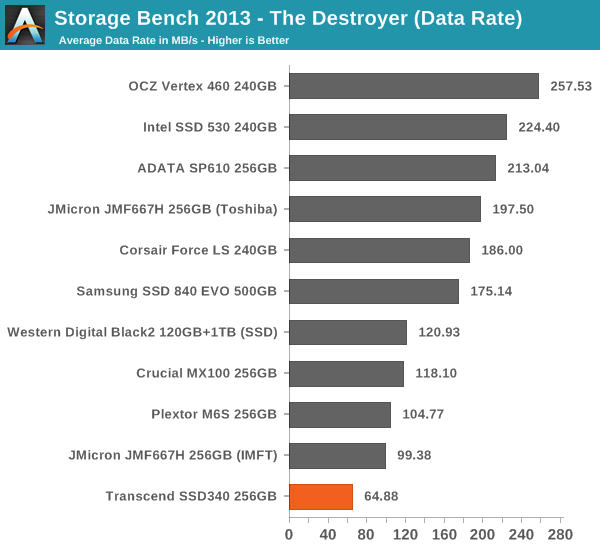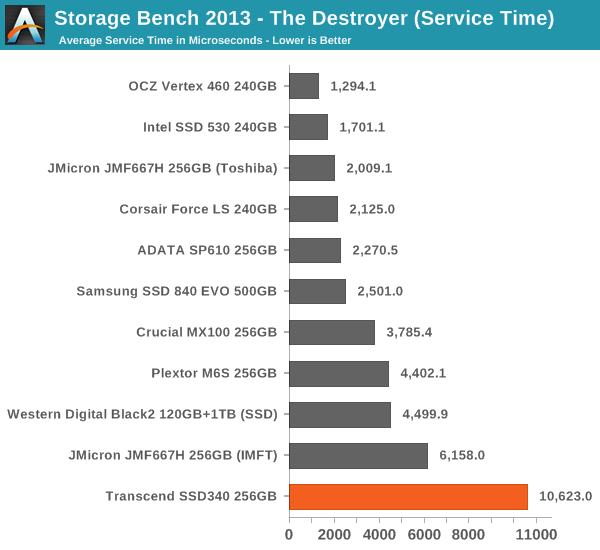Transcend SSD340 (256GB) Review
by Kristian Vättö on August 4, 2014 5:00 AM ESTAnandTech Storage Bench 2013
Our Storage Bench 2013 focuses on worst-case multitasking and IO consistency. Similar to our earlier Storage Benches, the test is still application trace based – we record all IO requests made to a test system and play them back on the drive we are testing and run statistical analysis on the drive's responses. There are 49.8 million IO operations in total with 1583.0GB of reads and 875.6GB of writes. I'm not including the full description of the test for better readability, so make sure to read our Storage Bench 2013 introduction for the full details.
| AnandTech Storage Bench 2013 - The Destroyer | ||
| Workload | Description | Applications Used |
| Photo Sync/Editing | Import images, edit, export | Adobe Photoshop CS6, Adobe Lightroom 4, Dropbox |
| Gaming | Download/install games, play games | Steam, Deus Ex, Skyrim, Starcraft 2, BioShock Infinite |
| Virtualization | Run/manage VM, use general apps inside VM | VirtualBox |
| General Productivity | Browse the web, manage local email, copy files, encrypt/decrypt files, backup system, download content, virus/malware scan | Chrome, IE10, Outlook, Windows 8, AxCrypt, uTorrent, AdAware |
| Video Playback | Copy and watch movies | Windows 8 |
| Application Development | Compile projects, check out code, download code samples | Visual Studio 2012 |
We are reporting two primary metrics with the Destroyer: average data rate in MB/s and average service time in microseconds. The former gives you an idea of the throughput of the drive during the time that it was running the test workload. This can be a very good indication of overall performance. What average data rate doesn't do a good job of is taking into account response time of very bursty (read: high queue depth) IO. By reporting average service time we heavily weigh latency for queued IOs. You'll note that this is a metric we have been reporting in our enterprise benchmarks for a while now. With the client tests maturing, the time was right for a little convergence.

Ouch, this is bad. The SSD340 is the slowest SSD in our 2013 Storage Bench and the difference is quite substantial. Given the results on the previous page along with the results here, it is clear that the SSD340 is not suitable for IO heavy workloads that require consistency. It still might have something to offer in lighter workloads, but that's looking increasingly doubtful.











57 Comments
View All Comments
jabber - Monday, August 4, 2014 - link
Hmm for most general use its reads not writes. So I doubt most normal folks would notice.hojnikb - Monday, August 4, 2014 - link
Again, install OS (win to go is pretty easy to setup for example) to a cheap flashdrive and come back :)Even though there is plenty more reads than writes in client world, its still important that random writes don't sux, because the moment OS will try to write something is the moment everything will freeze (think jmicron 602)
TheWrongChristian - Monday, August 4, 2014 - link
Random writes suck if they block reads. That was the problem with the old jmicron controllers, a high latency write would block everything including reads.With good command queuing, and non-blocking writes, reads should still be low latency, and for boot and application startup, it's read latency that counts. The OS can mask write latency pretty well, to the point that you're unlikely to notice much difference on a desktop.
On a server, you're much more likely to notice write latencies however. Think database servers writing log data, or a file server waiting for a file write before acknowledging a sync. But even there, a file server can batch write file updates from many clients (or use the sequential journal for data) and the database similarly decomposes synchronous writes to sequential log files.
So all in all, so long as writes don't block unrelated reads, you should be fine.
jabber - Tuesday, August 5, 2014 - link
As it happens I rebuilt a Sony all in one PC with just one of the exact drives in this review. Worked fine. Installed swiftly with no issues. There are benchmarks...and then there is using it in the real world and often real world is very different to those.Friendly0Fire - Tuesday, August 5, 2014 - link
The point is that according to the table in this review you can get a flat-out better SSD *for the same price*, unless you're looking for the 64gb size in which case a measly $20 will upgrade to 128gb. The value proposition just isn't there.jabber - Wednesday, August 6, 2014 - link
Well I got mine for £65 and the next cheapest 200+GB SSD was £85 so was worth it. Thats pounds...not dollars. Thats a $32 difference for very little difference in general usage.MrFixitx - Monday, August 4, 2014 - link
I am honestly not at all surprised by these results. Transcend has for years been the maker of "value" NAND based products. From camera memory cards to usb thumb drives.I have been burned by their compact flash cards before and would not recommend their flash based products for anything where reliability is critical.
velanapontinha - Monday, August 4, 2014 - link
Hi, Kristian.Any chance of reviewing the SSD370 line anytime soon? These are dirt cheap and should prove a lot better overall than the SSD340.
Kristian Vättö - Monday, August 4, 2014 - link
I don't have the drive yet but it's certainly on the list of SSDs to review.saliti - Tuesday, August 5, 2014 - link
What about Samsung 845 DC Pro review?